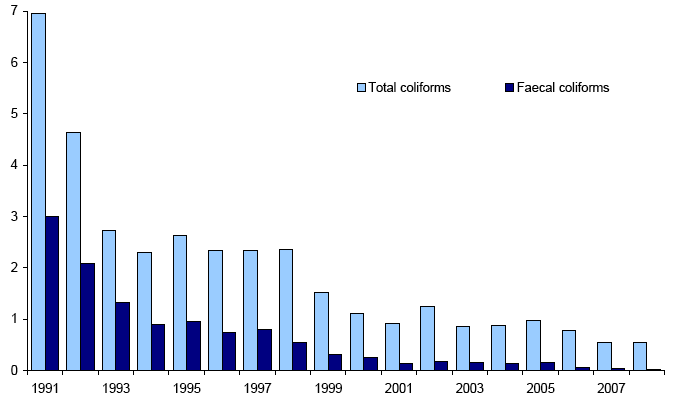Key Scottish Environment Statistics 2009
Annual publication containing summary of key statistics on environmental trends in Scotland
Water
Drinking Water Quality: 1991-2008
Percentage of samples at consumer's taps failing test

1991 |
1995 |
2000 |
2005 |
2006 |
2007 |
2008 |
|
|---|---|---|---|---|---|---|---|
Percentage failure for total coliforms |
6.95 |
2.63 |
1.12 |
0.97 |
0.77 |
0.54 |
0.55 |
Percentage failure for E.coli (faecal coliforms) |
2.99 |
0.95 |
0.24 |
0.15 |
0.06 |
0.03 |
0.01 |
The coliform group of organisms is present in large numbers in the gut of all warm-blooded animals and is also widely distributed in the environment. Their presence in tap water indicates a breach in the integrity of the water supply system.
Scottish Water is required to analyse samples taken from water treatment works, service reservoirs and consumers' taps. The Water Supply (Water Quality) (Scotland) Regulations 2001 set strict standards for compliance for a wide range of parameters. The major centres of population in Scotland are served by modern water treatment works, which are generally well equipped to achieve the standards set. In recent years improvements have been made to some of the small, rural treatment works, many of which were previously unable to consistently treat water to the standard required by the Regulations.
Between 1991 and 2008, the percentage of samples from consumer taps containing coliforms fell from 6.95% to 0.55% and the percentage failure for E.coli fell from 2.99% to 0.01%. Between 2007 and 2008 the failure rate for E.coli decreased by 0.02 percentage points whilst the failure rate for total coliforms increased by 0.01 percentage points.
There is a problem
Thanks for your feedback